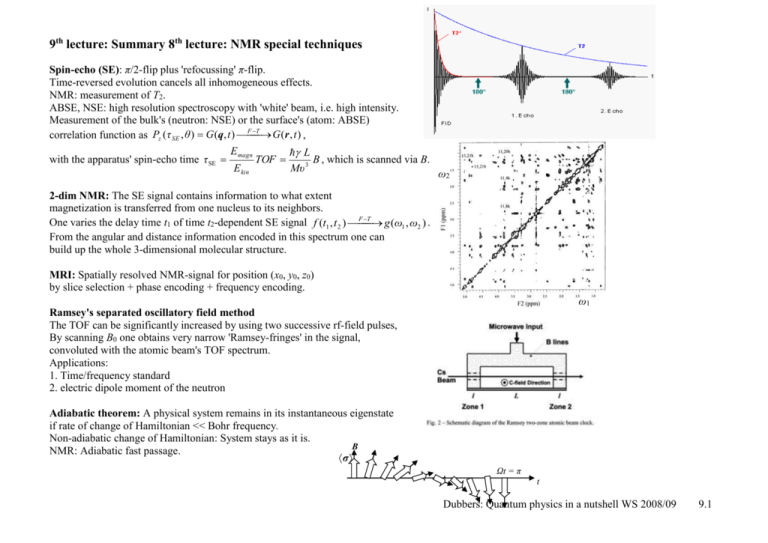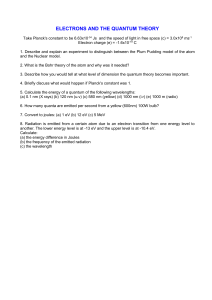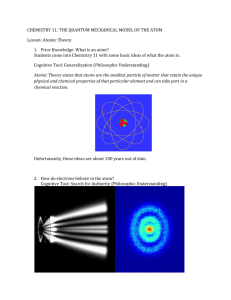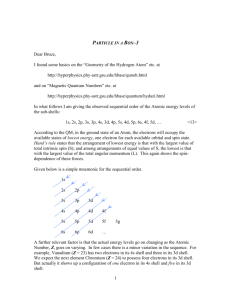Δk/k
advertisement

9th lecture: Summary 8th lecture: NMR special techniques Spin-echo (SE): π/2-flip plus 'refocussing' π-flip. Time-reversed evolution cancels all inhomogeneous effects. NMR: measurement of T2. ABSE, NSE: high resolution spectroscopy with 'white' beam, i.e. high intensity. Measurement of the bulk's (neutron: NSE) or the surface's (atom: ABSE) T G (r , t ) , correlation function as Pz ( τ SE , θ ) G (q, t ) F E magn L with the apparatus' spin-echo time τ SE TOF B , which is scanned via B. E kin Mυ 3 ω2 2-dim NMR: The SE signal contains information to what extent magnetization is transferred from one nucleus to its neighbors. T One varies the delay time t1 of time t2-dependent SE signal f (t1 , t 2 ) F g (ω1 , ω2 ) . From the angular and distance information encoded in this spectrum one can build up the whole 3-dimensional molecular structure. MRI: Spatially resolved NMR-signal for position (x0, y0, z0) by slice selection + phase encoding + frequency encoding. ω1 Ramsey's separated oscillatory field method The TOF can be significantly increased by using two successive rf-field pulses, By scanning B0 one obtains very narrow 'Ramsey-fringes' in the signal, convoluted with the atomic beam's TOF spectrum. Applications: 1. Time/frequency standard 2. electric dipole moment of the neutron Adiabatic theorem: A physical system remains in its instantaneous eigenstate if rate of change of Hamiltonian << Bohr frequency. Non-adiabatic change of Hamiltonian: System stays as it is. B NMR: Adiabatic fast passage. σ Ωt = π t Dubbers: Quantum physics in a nutshell WS 2008/09 9.1 5. Atomic effective spin-½ systems 5.1 Interaction of an atom with a classical laser field In our semi-classical treatment the laser photons are described by a classical electromagnetic wave, characterized by its electric field vector E E 0 e i ( k x t ) (negligible effects from B = E/c). We shall treat here only the dipole approximation, which assumes that the wavelength λ of the light is large compared to the dimensions r of the atom, typically λ ~ 500 nm vs. r ~ 0.2 nm. (Exceptions: Rydberg atoms with r ~ n2 ~ 200 nm for main quantum number n ~ 30; inner-shell x-ray transitions with λ ~ Å; nuclear γ-transitions, with r ~ λ ~ fm). In the dipole approximation, e ikx e i 2πx/ 1 , and E E 0 e it is the same all over the atom's volume. For the magnetic dipole interaction we had U magn μ B , with magnetic dipole moment μ γs 12 γσ . For the electric dipole interaction we have U el d E , with electric dipole moment d s 12 σ . In quantum mechanics, all tensors of the same rank are proportional to each other (Wigner-Eckardt theorem): In our case, the vectors μ and d are multiples of s. (The expectation value of d = er are the transition matrix elements d 21 er21 e Ψ 2 (r ) r Ψ 1 (r ) dV V over the atomic volume V, with the electronic wavefunctions Ψ1 (r ) and Ψ 2 (r ) of the initial and final states.) Hence, the effects of the electric dipole interaction can be described in exactly the same way as the effects of the magnetic dipole interaction discussed in the previous chapters. What causes the energy splitting E2 − E1 = ħω0 of our 'effective spin-½ system' is irrelevant, it can be a hyperfine interaction like in the case of the 133Cs time standard, or a tunnel-splitting like in the case of the NH3 maser, or the Zeeman or Stark effect ω0 γBz or ω0 κE z , or anything else. In all cases, the longitudinal polarization component is proportional to the population difference Pz σ z p2 p1 of the 'up' and 'down' energy levels. The transversal polarization is Px , y σ x , y is induced by a transversal interaction, e.g. ω1 γB x cos ωt in NMR or ω1 κEx cos ωt for a laser. Dubbers: Quantum physics in a nutshell WS 2008/09 9.2 E+ 5.2 Manipulation of atomic effective spin-½ systems using lasers The equation of motion of the atomic polarization under laser irradiation can therefore be described by the same Bloch equations as in the NMR case, they are then called the optical Bloch equations for the polarization P, with d 12 σ : ħω0 E− P ω0 P , with ω0 (ω1 , 0, ω0 ) , P σ (2 d x /κ , 2 d y /κ , p 2 p1 ) , acting on the 'Bloch sphere'. Also decay times play a very similar role as in NMR: P Px (ω0 ω) Py x , T2 Py , Py (ω0 ω) Px ω1 Pz T2 P Pz Pz ω1 Py z , T1 although the physical processes may be different: T1 may simply be the lifetime of the excited atom, T2 may be homogeneous decoherence due to atomic collisions (Lorentzian), or inhomogeneous decoherence due to Doppler broadening (Gaussian). 1 1 T2inhom (The frequently used formula T21 T2hom is strictly valid only for the convolution of 2 Lorentzians.) PRA 13, 2123 (1976): Dubbers: Quantum physics in a nutshell WS 2008/09 9.3 PRA 6, 2001 (1972): "Quantum beats" The precessing polarization of the atoms is observed via the precessing anisotropic emission of light, like in other spin-rotation experiments, cf. ch. 4.1. E(t) t S(t) t Dubbers: Quantum physics in a nutshell WS 2008/09 9.4 PR 141, 391 (1966) π/2: π: Dubbers: Quantum physics in a nutshell WS 2008/09 9.5 PRL 32, 814 (1974) ω0 − ω ωeff ω1 ω1 d ω0 ω dt ω1 Dubbers: Quantum physics in a nutshell WS 2008/09 9.6 PRL 48, 867 (1982) Dubbers: Quantum physics in a nutshell WS 2008/09 9.7 5.3 Perturbation theory (PT) a) Time-independent PT For the two-state system, the solution of the time-independent Schrödinger equation is exact, and we do not need PT. However, it is useful to recall the main results of time-independent PT and compare it with the exact results. We discuss the case of the Zeeman effect with constant Bz, plus off diagonal constant Bx (possibly in the rotating frame), which is representative for all two-state systems with time-independent H: 1. Exact results (cf. p. 2.8): ω1 ω cos φ sin φ is diagonalized by U , 0 sin φ cos φ ω1 ω0 whose columns are the eigenvectors of H, with mixing coefficients: H 1 2 cos φ 1 2 1 1 1 1/ 2 1/ 2 , sin φ 1 2 1 1 1 1/ 2 1/ 2 , and 1 ω1 , ξ ω0 cosφ ≈ 1 1/ 2 and with energy eigenvalues E 12 ω02 ω12 12 ω0 1 ω12 /ω02 . 2. Approximate results from Taylor expansion of exact result: For ω1 ω0 , the mixing coefficients become, to 1st order: cos φ 1 2 11 1 2 2 1/ 2 1 and sin φ 1 2 1 (1 1 2 sinφ ≈ 1/2ξ ) 2 1/ 2 ω 1 1 . 2ξ 2ω0 With E 12 (ω0 ω12 / 2ω0 ) , the energy splitting increases to E E E (ω0 ω12 / 2ω0 ) , to 2nd order. Dubbers: Quantum physics in a nutshell WS 2008/09 9.8 3. Approximate results from Perturbation-Theory: PT gives approximate results for the Hamiltonian H H 0 V , when the solutions of H0 are known and V is small (without proof): 0 ω V V 1 0 , perturbation V 11 12 , for basis ψ1 and ψ 2 : With H 0 12 0 0 1 V21 V22 0 ω0 To order zero: The eigenvalues are the unperturbed E 12 ω0 . The eigenfunctions are the unperturbed ψ1 , ψ 2 . To 1st order: The perturbed eigenvalues are shifted by the diagonal elements of V, taken with the unperturbed eigenfunctions: E(1) E ψ1 V ψ1 E V11 12 ω0 V11 , E (1) 12 ω0 V22 . V22 1 2 ω0 1 2 ω 0 V11 The perturbed eigenfunctions are derived from the unperturbed eigenfunctions and energies as V12 ω ψ1(1) ψ1 ψ 2 ψ1 1 ψ 2 , with V12 12 ω1 , and E1 E2 2ω0 V12 ω ψ 2(1) ψ 2 ψ1 ψ 2 1 ψ1 . E2 E1 2ω0 E4 This equals our approximate result from Taylor expansion above: ω ψ1(1) ψ1 cos φ ψ 2 sin φ , with cos φ 1 and sin φ 1 . E3 2ω0 E2 E2(2) To 2nd order: the perturbed eigenvalues are: V122 ω2 ω2 E ( 2) E V11 12 ω0 ε1 1 and E ( 2) 12 ω0 ε1 1 , E1 E1 E 2 4ω0 4ω0 and the energy splitting becomes E E E (ω0 ω12 / 2ω0 ) , in agreement with the above, etc... 2 In general: E (1) n En ψ n V ψ n En Vnn , ψ (1) n Vnm Vnm , ... ψn ψ m , E n( 2) E n Vnn n m En Em nm En Em Dubbers: Quantum physics in a nutshell WS 2008/09 9.9 b) Time-dependent PT 2-dim Schrödinger equation: iψ Hψ with time-dependent Hamiltonian H (t ) H 0 V (t ) , with small V(t), and known basis states of H0 (we temporarily use bra-kets): 1 0 | ψ1 e iE1t/ and | ψ 2 e iE2t/ | ψ1 0 1 (that is: i | ψ 1 E1 | ψ1 , i | ψ 2 E2 | ψ 2 , and orthonormality: ψ1 | ψ1 ψ 2 | ψ 2 1, ψ1 | ψ 2 0 ). V(t) | ψ2 The time development of ψ in terms of this basis is | ψ c1 | ψ1 c2 | ψ 2 , with unknown time-dependent coefficients c1(t), c2(t). Insert this into iψ Hψ , using the chain rule: i(c1ψ1 c1ψ 1 c2ψ 2 c2ψ 2 ) ( H 0 V )(c1ψ1 c2ψ 2 ) , or ic1ψ 1 ic2ψ 2 ic1ψ1 ic2ψ 2 c1 H 0ψ1 c2 H 0ψ 2 c1Vψ1 c2Vψ 2 . The first two terms on each side are the unperturbed Schrödinger equation and cancel, and (again with bra-kets) we are left with: ic1 | ψ1 ic2 | ψ 2 c1V | ψ1 c2V | ψ 2 . Multiplication from the left with ψ1 | gives ic1 ψ1|ψ1 ic2 ψ1|ψ 2 c1 ψ1|V|ψ1 c2 ψ1|V|ψ 2 . With ψ1|V|ψ1 V11 , ψ 2|V|ψ 2 e iE1t/ ( 0 1 ) V11 V12 1 e iE2t/ V21e i ( E2 E1 )t/ V21 V22 0 this becomes: ic1 c1V11 c2V12 e i ( E2 E1 )t/ . The same procedure, after multiplication with ψ 2 | , gives ic2 c2V22 c1V21e i ( E2 E1 )t/ , where all c's- and V's can be time-dependent. Dubbers: Quantum physics in a nutshell WS 2008/09 9.10 Time-dependent perturbation theory is known to give the following approximate solutions for these coupled equations (without proof): To order zero: the eigenfunctions of H0 do not change under V(t) ic1(0) 0 , ic2( 0) 0 . To 1st order: ic1(1) c1(0)V11 c2(0)V12 e i ( E2 E1 )t/ , ic2(1) c2(0)V22 c1(0)V21e i ( E2 E1 )t/ . To kth order: ic1( k ) c1( k 1)V11 c2( k 1)V12 e i ( E2 E1 )t/ , ic2( n) c2( n1)V22 c1( n1)V21e i ( E2 E1 )t/ . (general case: icn( k ) m cm( k 1)Vnm e i ( Em Em )t/ .) 0 ω1 (t ) ω 0 , and V (t ) 12 , 0 0 ω1 (t ) 0 ω0 i.e. E 2 E1 ω0 , V12 12 ω1 , V11 V22 0 , and for initial condition c1 = 1, c2 = 0 at t = 0, to first order: For H 0 1 2 ic1(1) c1( 0)V11 c2( 0)V12 e iω0t 0 0 0 , that is c1(1) remains unchanged: c1(1) (t ) 1 , and the probability amplitude c2 for transition between the states is E2 ic2(1) c2( 0)V22 c1(0)V21e iω0t 0 12 ω1 (t )e iω0t , ħω0 1 t E1 with the solution c 2(1) (t ) ω1 (t ' )e iω0t ' dt : 0 2i 2 1 t For a small excitation ω1 (t ) the transition probability is P12 ω1 (t ' )e iω0t ' dt . 4 0 | ψ2 P12 | ψ1 General case: higher-order time-dependent perturbation theory requires multiple integrations over time, and diagrammatic techniques (Feynman diagrams) are used for book-keeping purposes. Dubbers: Quantum physics in a nutshell WS 2008/09 9.11 5.4 Photon absorption and emission So far we have described transitions between upper energy level E2 and lower energy level E1 by π-flips of the Bloch vector, either up or down, without discussing energy or angular momentum conservation. 1st-order time-dependent perturbation theory gives us a hint how this happens. Let a laser be switched on at time t = 0, that is V12 is a harmonic excitation for t ≥ 0. ω t Then, to 1st order, c2(1) (t ) 1 2 cos ωt ' e iω0t ' dt . 2i 0 Writing 2 cos ωt ' e iω0t ' e i ( ω0 ω)t ' e i ( ω0 ω)t ' we obtain, after integration, the 1st-order solution, and for ω1 ω0 , the transition probability P12 c (1) 2 2 2 1 sin 2 12 (ω0 ω)t 2 (ω0 ω)t 2 sin . ω ω1 2 (ω0 ω) (ω0 ω) 2 2 1 sin x x 2 The function (sin x / x) 2 has appreciable values only for x << 1. (N.B.: This function also describes the diffraction pattern from a single slit.) Therefore, under irradiation with frequency ω > 0, the transition probability has non-negligible intensity only 1. for ω0 ω 2 / t , that is at ω0 ω 0 within a width ω 2 / t (uncertainty relation), 2. for ω0 ω 2 / t , that is at ω0 ω 0 within a width ω 2 / t . (For long times, P12 (ω) → δ-functions at ω = ±ω0; for short times P12 (t ) t 2 , cf. p. 3.3.) In the first case, state 1 is the upper state and energy ħω0 is emitted: E E2 E1 ω0 0 , in the second case, state 1 is the lower state and energy ħω0 is absorbed: E ' E1 E2 ω0 0 . Energy is thought to be conserved by the emission or absorption of a photon of energy ħω0. Both induced emission and absorption have the same probability (cf. Einstein coefficients B12 = B21). Spontaneous emission (Einstein coefficient A12) will be discussed later (for the magnetic interactions discussed so far, spontaneous emission is negligible). Dubbers: Quantum physics in a nutshell WS 2008/09 9.12 In the Bloch precession description, both photon emission (with ω0 0 ) and photon absorption (with ω0 0 ) are induced by the same right-rotating component B1 (t ) (or the left-rotating component B1 (t ) when the magnetic moment has opposite sign). This is shown with the following example, based on angular momentum conservation. before: 1. Absorption Δm = +1: atom in groundstate plus photon m 12 M 1 2. Spontaneous emission Δm = −1: atom in excited state m 12 3. Induced emission Δm = −1: atom in excited state m 12 plus photon M 1 after: atom in excited state m 12 m=+½ B12 B21 A21 m=−½ atom in groundstate m 12 plus photon M 1 atom in groundstate m 12 plus two photons M 1 M 1 . = 2 bosons in the same state. In all 3 cases, only M = +1 photons are involved, i.e. right-circular polarized photons, when linear momentum is parallel to spin , and left- circular polarized, when linear momentum is antiparallel to spin . Only M = −1 photons are involved when the magnetic moment has opposite sign, in which case the groundstate has m = +½. Dubbers: Quantum physics in a nutshell WS 2008/09 9.13









